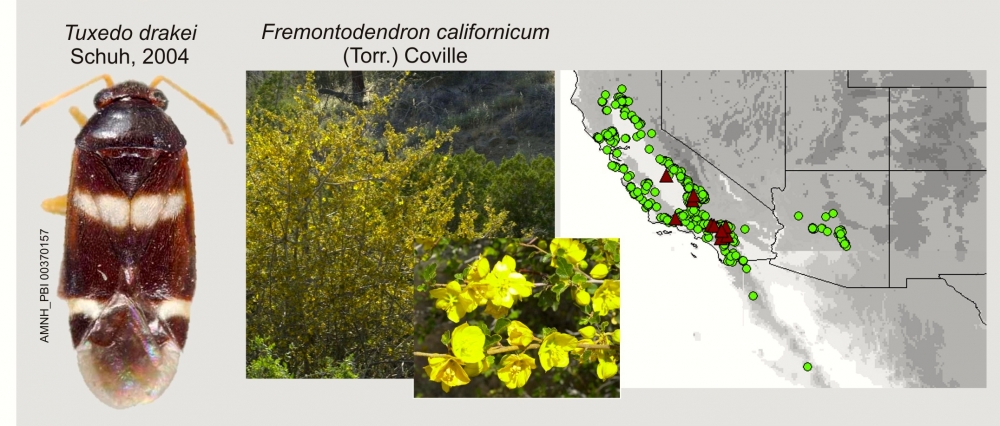
Bug Collecting

Amateur and professional entomologists are experts at their own version of Pokémon Go. After all, part of their job is to search for and collect rare insect species that are stored in the archives of natural history museums.
Even the director of UC Santa Barbara’s Cheadle Center for Biodiversity & Ecological Restoration has gotten in on the “game.” Katja Seltmann, an entomologist and parasitic wasp specialist, is co-author of a new paper that examines the North American distribution of some real-life Pokémon — insect species in the Miridae family, also known as plant bugs.
Seltmann and colleagues from UC Riverside, the University of Wisconsin-Madison and the American and Florida museums of natural history analyzed thousands of digitized records of plant bug species. Drawing on data from a decade of work by plant bug specialists in North America — including that of co-authors Michael Schwartz and Randall Schuh of the American Museum of Natural History — the scientists determined that while insect distribution is closely related to that of the host plants on which they feed, its range is much smaller. The group’s findings appear in the journal Cladistics.
“These insects are amazing as they have piercing, sucking mouth parts,” Seltmann explained. “It’s like having an insect with a hypodermic needled attached to its head. The bug sticks its ‘needle’ into plants to suck out their juices. Because of this intimate way of feeding, many species in this family are host-specific, meaning that they feed only on specific plants that supply the food they need.”
The researchers examined data from 1,339 plant bugs to detect areas of endemism — special places where unique animals and plants reside. Many of those unique areas are in California, a state with great biodiversity. Seltmann noted that insects generally have not been used in this kind of research, yet they may be a more appropriate choice.
For one thing, data has become more available thanks to natural history museums making information accessible online and open to the public through databases like iDigBio. “It’s a lot of work, but our paper demonstrates that this availability results in productive research,” Seltmann said. “Natural history collections are really the only place this kind of information exists, as many of the species in collections are collected infrequently by insect specialists whose work it is to describe and capture new species.”
Second, the incredible diversity of insects makes them excellent subjects for study. Only about 6,000 mammal species exist, while insect species number 1 million or more. Working with myriad insect types not only provides a different scale, it also gives scientists access to organisms that play many different roles in an ecosystem.
According to Seltmann, the main question when searching for existing areas of endemism — as this new research did — is what scale scientists should consider when looking for endemic areas.
“If you’re interested in categorizing an ecosystem, it may be important to look at smaller organisms, not just the larger ones, because the range, ability to disperse and habitat role of a large mammal is different than that of a small insect,” she said. “If we’re talking about the diversity of organisms in endemic areas, then we really need to look at the smaller species to give us the big picture.”
The distributions of host plants and insects also turned out to be an important factor. The investigators hypothesized that the area where the insects live would be smaller than that of the host plants — which is exactly what they found.
“If the plants have a range of 50 kilometers, then the insect’s distribution is going to be nested within that plant range,” Seltmann explained. “The boundaries are actually pretty wide between the edges of where the plant bug is and where its host lives because there is flux. In addition, die-offs as well as migration, movement and dispersal occur in one direction or another. You don’t want to be an insect that feeds on a specific plant that’s all of a sudden stuck in a place without a food source. That makes biological sense.”
A good example is the uncommon species Tuxedo drakei, a plant bug discovered in 2004 by Schuh. This insect feeds on Fremontodendron, a very common California native also known as flannel bush. Scientists don’t know why there aren’t more Tuxedos on the shrubs or why the bugs only cluster in certain areas, but Seltmann said the reasons could be myriad.
“There could be environmental sensitivity that the plants themselves don’t exhibit or distributions of competitors could be causing an issue,” Seltmann said. “Something else is controlling the distribution besides just the availability of plant hosts. That is a really interesting concept because the insect microclimate is very much the plant. So what else could it possibly be? It’s an open question; we just don’t specifically know.”
As a next step, the research team will perform species distribution modeling.
“Instead of looking at individual data points, we want to look at hypothesized range maps based on host plants and on the kinds of habitats in which the insect is known to already exist,” Seltmann said. “That way, we can hypothesize an insect’s range even though it was only collected in two places.”



